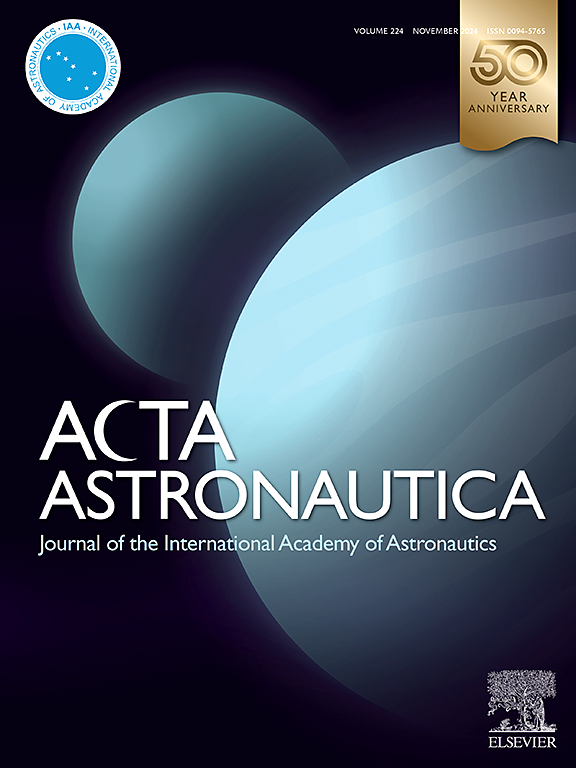基于红外图像轮廓的小体自主形状建模
IF 3.1
2区 物理与天体物理
Q1 ENGINEERING, AEROSPACE
引用次数: 0
摘要
对小天体的任务需要精确的形状特征来进行导航和科学研究。本文提出了一种利用人体在一组红外图像中的视觉范围(轮廓)来推断其三维形状的轮廓提取算法。该算法利用来自不同图像的光线(每个对应一个轮廓像素)之间的交叉点来提取小体型。提出了一种新的采样方法,从每个图像中最优地提取相关的轮廓像素,为形状建模过程提供显著信息。这减少了算法的计算量,同时保留了每个图像的显著形状信息。红外图像的使用确保了算法对照明几何形状的鲁棒性。将SfS算法应用于4个小天体在0°和45°两个不同进近纬度的合成图像。在接近纬度为0°时,Bennu、Itokawa、67P/C-G和Eros模型的均方根误差分别为1.333 m、4.056 m、53.99 m和341.6 m。在接近纬度为45°时,Bennu、Itokawa、67P/C-G和Eros模型的均方根误差分别为3.159 m、4.672 m、54.27 m和217.1 m。该算法对极点误差(2−10°)的敏感性是四个物体的特点,随着误差的增加,性能会出现预期的下降。与Bennu相比,Itokawa, 67P/C-G和Eros的退化更严重,因为它们的形状更不规则。该算法还应用于隼鸟2号飞船上的TIR相机拍摄的真实红外图像,以生成小行星龙宫的形状模型。该形状模型的均方根误差为8.652 m。该算法可用于未来的任务,如HERA和隼鸟2 #,以获得初始形状模型的目标物体使用机载红外图像。本文章由计算机程序翻译,如有差异,请以英文原文为准。
Autonomous shape modeling of small bodies using infrared image silhouettes
Missions to small bodies require accurate shape characterization for navigation and scientific purposes. In this paper, a Shape from Silhouette (SfS) algorithm is presented which uses the visual extents of the body (silhouettes) in a set of infrared images to infer its three-dimensional shape. The algorithm leverages intersections between rays (each corresponding to a silhouette pixel) from different images to extract the small body shape. A novel sampling method is introduced to optimally extract the relevant silhouette pixels from each image that provide salient information to the shape modeling process. This reduces the computational burden of the algorithm while preserving the salient shape information from each image. The use of infrared images ensures the robustness of the algorithm to lighting geometries. The SfS algorithm is applied to synthetic images of four small bodies at two different approach latitudes of 0° and 45°. At a 0° approach latitude, the resultant shape models have an RMS error of 1.333 m, 4.056 m, 53.99 m, 341.6 m for Bennu, Itokawa, 67P/C-G, and Eros respectively. At a 45° approach latitude, the resultant shape models have an RMS error of 3.159 m, 4.672 m, 54.27 m, 217.1 m for Bennu, Itokawa, 67P/C-G, and Eros respectively. The algorithm’s sensitivity to pole errors (of ) is characterized for the four bodies which shows an expected degradation in performance as the error increases. The degradation is worse for Itokawa, 67P/C-G, and Eros compared to Bennu due to their more irregular shape. The algorithm is also applied to real infrared images taken by the TIR camera on-board the Hayabusa2 spacecraft to generate a shape model of asteroid Ryugu. The RMS error of this shape model is 8.652 m. This algorithm can be used in future missions such as HERA and Hayabusa2 to obtain initial shape models of the target objects using on-board infrared images.
求助全文
通过发布文献求助,成功后即可免费获取论文全文。
去求助
来源期刊

Acta Astronautica
工程技术-工程:宇航
CiteScore
7.20
自引率
22.90%
发文量
599
审稿时长
53 days
期刊介绍:
Acta Astronautica is sponsored by the International Academy of Astronautics. Content is based on original contributions in all fields of basic, engineering, life and social space sciences and of space technology related to:
The peaceful scientific exploration of space,
Its exploitation for human welfare and progress,
Conception, design, development and operation of space-borne and Earth-based systems,
In addition to regular issues, the journal publishes selected proceedings of the annual International Astronautical Congress (IAC), transactions of the IAA and special issues on topics of current interest, such as microgravity, space station technology, geostationary orbits, and space economics. Other subject areas include satellite technology, space transportation and communications, space energy, power and propulsion, astrodynamics, extraterrestrial intelligence and Earth observations.
 求助内容:
求助内容: 应助结果提醒方式:
应助结果提醒方式:


